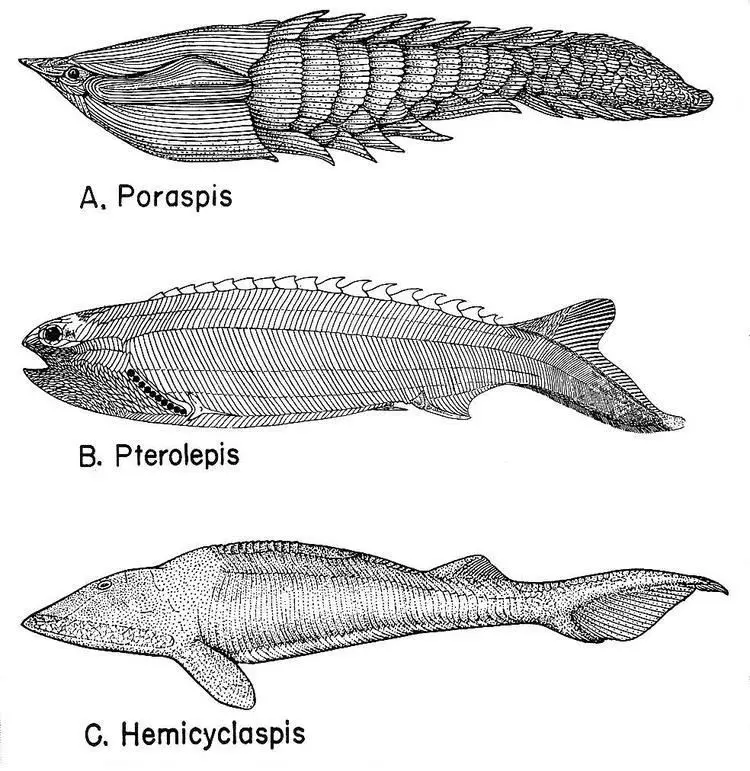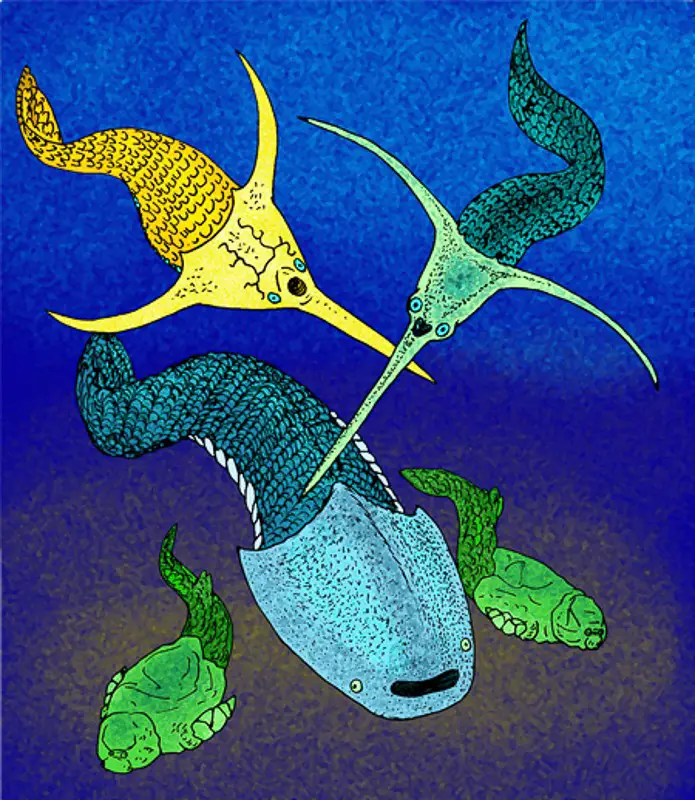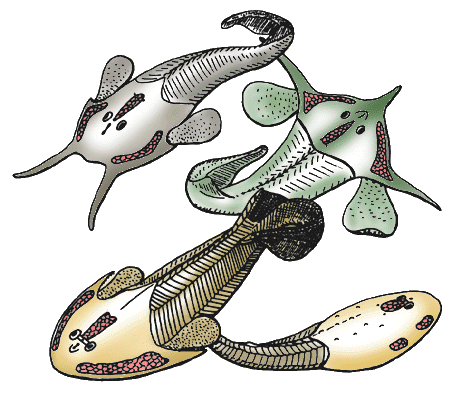Ostracoderms are today extinct so we can not study all features in a living state but on the basis of available fossils, we can divide class Ostracodermi into 2 subclasses.
Table of Contents
Subclass 1: Monorhina:
The important feature of this subclass is the presence of a large-sized, slit-like median eye present on the head between the two eyes. Subclass Monorhina is divided into three orders, order Euphanorida, order Anaspida, order Osteostraci.

Order 1: Euphanorida:
- The members of order Euphanorida was in peak during Silurian period.
- Order Euphanorida has only one genus and on this single genus only one species present, Jamoytius kerwoodi but previously this Ostracoderm was placed under Anaspida.
- Members of order Euphanorida was found in Silurian strata of England and it was assumed as Ammocoet larva of Ostracoderm.
- Size is medium around 18 cm in length and the external body appearance is fusiform and the head is blunt and do not have shield.
- On the trunk they have indication of paired lateral fin fold and unpaired median fin fold.
- The segmented muscle like myotomes present in Branchiostoma also present in this order.
- Members of this order is considered as the primitive ancestors of Ostracoderm, pharyngeal gill slits are not present in this order.
Order 2: Anaspida:
- Members of Anaspida order become peak during late Silurian period to Devonian period.
- Body size is smaller than order Euphanorida, members of this order have a length around 15 cm.
- Head maybe covered by armour like plate or maybe the head is naked.
- The body is armoured with scale like plate but the arrangements of the body shield is irregular type, in trunk region the scales aranged in longitudinal rows.
- On anterior end of head mouth present terminally and the eyes present on lateral side of the head, only one nostril median present.
- Paired appendages present in the form of paired spines on pectoral region.
- On trunk along the mid dorsal line a series of spin present, spine also present near anus known as anal spine.
- Around 8 gill slits present on anterior side of pecoral spine in obliquely.
- They able to swim actively and the post anal tail have asymmetrical shape, the lower lobe of tail is larger.
- Some important members of this order Anaspida are, Lasanius, Rhyncholepis, Pharyngolepis, Petroleps.

Order 3: Osteostraci:
- They are also known as Cephalaspida and they become peak during Silurian period to Devonian period.
- The head is covered by a large sized unjointed shield like carapace or scale.
- The tail is asymmetrical or heterocercal with the upper lobe of tail is much larger than the lower lobe.
- Large number of gill slits present and on behind the gill slits a pair of palps function as pectoral fin.
- On head sensory field present and the lateral eyes present much closer to each other.
- Some important members of this order are, Hemicyclaspis, Cephalaspis, Tremataspis, Didymaspis.
Subclass 2: Diplorhina:
The main feature of subclass Diplodhina is the nasal opening is not single here, two nostrils are present and open outside separately.
Order 1: Heterostraci:
- Members of order Heterostraci was in peak during Silurian period to Devonian period and they also known as Pteraspida.
- The size is much larger and the head is protected by a large sized sheld like scale.
- The tail is laterally compressed and is covered by small scales and the tail is hypocercal with large sized lower lobe.
- Anterior part of the mouth portion is elongated into rostrum and the mouth opening is large aperture.
- Gill slit is only one pair laterally and it is large sized, lateral eyes are present much apart to each other.
- The head shield have a spine directed in backward direction and the trunk is covered by triangular shaped shield.

Order 2: Coelolepida:
- Members of order Coelolepida were in peak level during the Silurian period to Devonian period.
- Body size is much smaller around 10 cm to 12 cm in length.
- The body shape is fusiform and the body is covered by large number of minutes scale like denticles.
- Tail is asymmetrical and the lateral eyes present much apart to each other.
Reference Ostracodermi Characteristics Classification Timeframes
Detailed Study On
Ostracodermi and its important Feature
Phylogeny of Subphylum Vertebrata
An Overview of Classification in Subphylum Vertebrata
Subphylum Vertebrata and its Diversity
Cephalochordata Characteristics Features Classification Examples and Diagram
Urochordata Classification Morphology Characteristic Features
Characteristics Features of Hemichordata
General Comparison of Hemichordata Urochordata and Cephalochordata
Comparative Study of Digestive System in Hemichordata Cephaochordata and Urochordata
Characteristics Features of Subphylum Vertebrata
Hi Everyone!!! Welcome to Imaluop. Imaluop always try to learn some new and he want to share to other people. Here we will try to learn various topics on Science, specially on Biological Sciences.